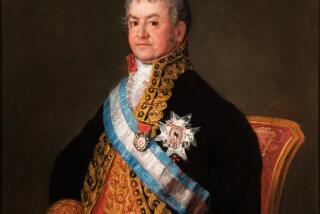Charting His Life : Collector Navigates Through the World of Antique Maps
- Share via
WOODLAND HILLS — When Robert Ross began collecting antique maps as a hobby 15 years ago, he never suspected he was charting a new career.
Ross discovered these fragile, exquisitely detailed items in 1979, when his wife gave him a map she had purchased at a small shop in Monterey.
“You paid $10 for this old piece of paper?” said Ross of the hand-colored, 8-by-10-inch travel map, which was neatly folded inside a wallet-sized pouch.
He later learned that the map, depicting southern Italy, was made between 1720 and 1740. Its appraised value today? $300.
“I will never sell it,” said Ross, a retired Calabasas high school principal, who studied history and geography at UCLA. He added that such maps are very rare. “I’ve never seen another like it.”
Since that first acquisition, Ross’ collection has grown enormously.
With more than 2,000 for sale, he claims to be one of the largest antique map dealers on the West Coast.
“Collecting maps is like collecting other antiques, old books, coins and stamps,” said Ross, who operates Antiquarian Maps, Prints and Related Books from his Woodland Hills home. “Maps are uniquely beautiful objects.”
His maps date from 1553 to 1890. He buys some at local auctions and travels to Europe in pursuit of others. He buys 19th Century material from New England. He also purchases maps by mail from a dealer in Paris.
He buys based on scarcity, rarity and subject.
Ross is especially fond of pre-1820 maps printed on handmade rag paper, ensuring longevity. He likes their beautiful engravings of ships, sea monsters and elaborately costumed figures.
The most expensive piece Ross has for sale is an $8,000, double-hemisphere map entitled Orbis Terrarum Nova Et Accuratissima Tabula --Latin for A New and Accurate Map of the Whole World. It was published in Amsterdam in 1666 by a man named Pieter Goos.
Ross explained that the piece’s value is based on its fine details, some etched in real gold.
The map depicts both sides of the globe, painted on a backdrop of blue sky, with a large, elaborate sun casting golden rays throughout the background. Head winds are painted on all four corners, while colorful, human figures at the bottom depict the four seasons.
Although buyers have made offers, Ross said he has yet to find anyone willing to pay the asking price.
The oldest map in his collection was an oval Italian world map made in 1528. It sold for $1,700. More recent maps include a 1925 version of Los Angeles and Ventura counties, and a 1932 California Highway Patrol survey.
Ross also carries “manuscript maps,” which, unlike mass-printed versions, are one-of-a-kind.
An artisan would draw a manuscript map by hand, and an engraver would then copy the work to wood, copper, steel or stone, which would become the printing plate.
“These are fine works of geography and art,” said Ross. “They are original pieces--centuries old, hand-drawn and colored.”
While Ross is often tempted to keep rather than sell his maps, he finds satisfaction in selling them to people who are enticed to the art of map collecting.
The lure for collectors, he said, is in owning something made by individual craftsmen and artisans, who often produced them from drawings by famous explorers.
Ross said ancient maps of North America or the Western Hemisphere are in great demand because they depict the “most notorious geographical misconception of all time”--that California was an island.
Many old American maps showing Pony Express and mail routes, Native American paths and early turnpikes also contain geographic inaccuracies.
“They can depict areas now lost in history,” said Ross. “They often show curious inaccuracies--the result of myth and explorers’ fabrications.”
Ross’ advice to new map collectors is to first read a general cartographic reference book and visit a reputable dealer in antiquarian maps.
“Try to determine some idea as to what types of maps you wish to collect based on what appeals to you,” said Ross.
He believes the majority of collectors are attracted to the decorative quality of early maps, while other collectors concentrate on a particular area, such as one’s country, state, region or city of birth.
“It is a matter of personal taste, preference and how much one wishes to spend,” said Ross. “It’s a fascinating hobby.”
More to Read
Sign up for The Wild
We’ll help you find the best places to hike, bike and run, as well as the perfect silent spots for meditation and yoga.
You may occasionally receive promotional content from the Los Angeles Times.






